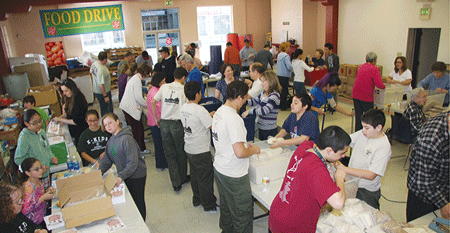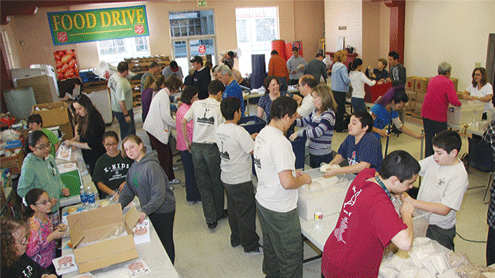
Glendale Kiwanis Club fills the shelves of The Salvation Army’s food pantry.
By Rio Ray, Captain
Tons of food—that’s what The Salvation Army in Glendale (Calif.) needed to help feed the increased numbers of people in need.
The Kiwanis Club of Glendale wanted some way to fill the shelves of The Salvation Army’s food pantry. As in other communities, Glendale’s food pantry has experienced a huge increase in clients over the last four years, now serving 200 percent more than before the recession began in 2008.
Kiwanis Club member Dave Cormier wondered how he could help.
“I saw so many needy people but didn’t think my buying a few extra bags of food would make a difference,” he said.
Cormier had served in the U.S. Army in the 1990s and was often attached to United Nations Peacekeeping Forces serving in such places as Bosnia, Croatia and Somalia. Frequently, his mission was to provide an armed escort for the delivery of large bags of rice in war-torn and ravaged countryside areas.
“What if we could buy a ton of food and give it to The Salvation Army?” he thought.
Thus the rice and beans project was born.
Now, every three months Kiwanis buys one ton of beans and one ton of rice and then repackages them into family sized portions. The “R&B Festival,” as it is known, draws over 50 volunteers, with ages ranging from 6 to 86. Each bag of beans and rice is marked, “Packaged by people who care.” The 50 volunteers are able to repackage 4,000 pounds of food in four hours.
Vince Espinoza, who helps lead the group, said, “The rice and beans project brings the community together; it’s multicultural and multigenerational; it bonds us to the same cause: to provide food for families that are struggling.”
Espinoza has been speaking to foundations and Kiwanis Clubs about starting the rice and beans project in other areas. “It is my dream that other communities and other Salvation Army centers will try this same project,” he said, “because you see immediate impact and you know that you are feeding people the very next day.”











